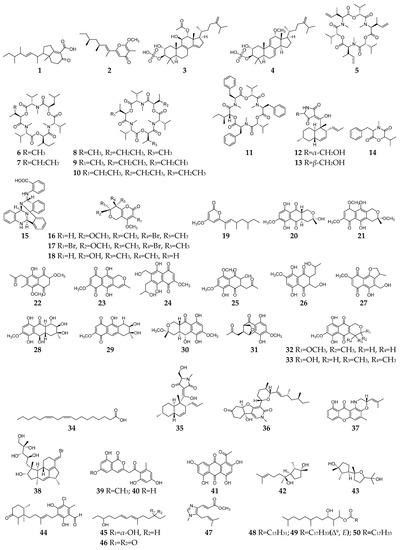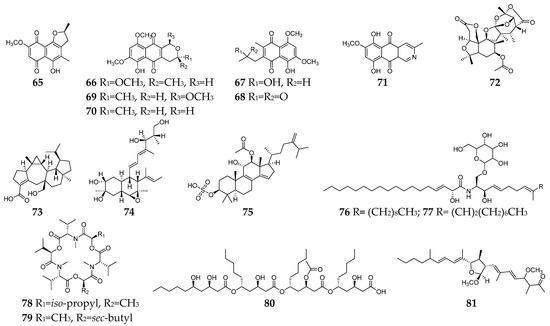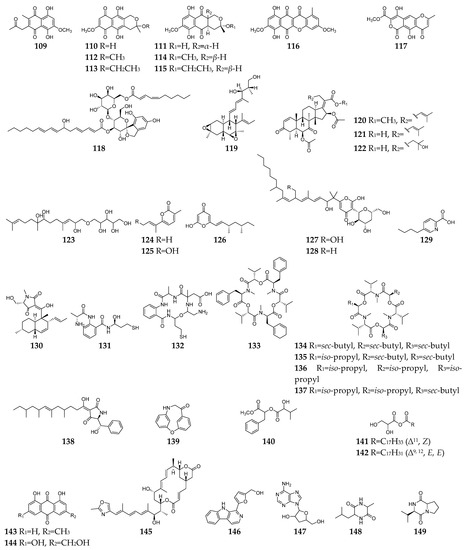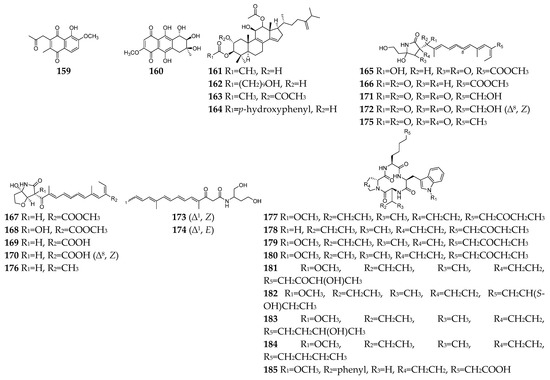2. Antibacterial Secondary Metabolites
Bacterial infection is a common clinical disease that can affect a variety of organs and tissues. Fusarium-derived antibacterial SMs have a wide array of structural motifs, most of which are polyketides, followed by alkaloids, terpenoids, and cyclopeptides. According to antibacterial properties, these chemicals are divided into three groups, including anti-Gram-positive bacterial SMs (1–50, Figure 1), anti-Gram-negative bacterial SMs (51–64, Figure 2) and both anti-Gram-positive and anti-Gram-negative bacterial SMs (65–81, Figure 3).
Figure 1. Fusarium-derived anti-Gram-positive bacterial SMs (1–50).
Figure 2. Fusarium-derived anti-Gram-negative bacterial SMs (51–64).
Figure 3. Fusarium-derived anti-Gram-positive and anti-Gram-negative bacterial SMs (65–81).
2.1. Anti-Gram-Positive Bacterial SMs
Fifty
Fusarium-derived SMs (
1–
50,
Figure 1) had been characterized and displayed various bactericidal effects on Gram-positive strains, such as
Staphylococcus aureus, methicillin-resistant
Staphylococcus aureus, multidrug-resistant
S. aureus,
Mycobacterium tuberculosis,
Bacillus subtilis, etc. Fusariumins C (
1) and D (
2) are two new polyketides produced by an endophytic strain
F. oxysporum ZZP-R1 from coastal plant
Rumex midair Makino displayed medium effect on
S. aureus with MIC (minimum inhibitory concentration) values of 6.25 and 25.0 μM, respectively
[3]. Two triterpene sulfates (
3 and
4) isolated from
F. compactum exhibited weak activity toward
S. aureus and
Streptococcus strains in the range of 6–50 µg/mL
[4]. Enniatins (
5–
10), a group of antibiotics commonly synthesized by various
Fusarium strains, are six-membered cyclic depsipeptides formed by the union of three molecules of D-α-hydroxyisovaleric acid and three
N-methyl-
L-amino acids
[5]. Three enniatins (
8–
10), beauvericin A (
11) and trichosetin (
12) were obtained from an endophytic fungus,
Fusarium sp. TP-G1 and showed moderate anti-
S. aureus and anti-methicillin-resistant
S. aureus effects with MIC values in the range of 2–16 µg/mL
[6]. Two enantiomers (
12 and
13) were separated from the culture broth of
F. oxysporum FKI-4553 and found to have an inhibitory effect on the undecaprenyl pyrophosphate synthase activity of
S. aureus with IC
50 values of 83 and 30 µM, respectively
[7].
Lateritin (
14) derived from
Fusarium sp. 2TnP1–2 showed anti-
S. aureus activity at 2 µg per disc with 7 mm of inhibition zone
[8]. A new polycyclic quinazoline alkaloid (
15) displayed moderate antibacterial activity against methicillin-resistant
S. aureus and multidrug-resistant
S. aureus, with the same MIC value of 6.25 µg/mL
[9]. Three pyranopyranones (
16–
18) showed weak inhibitory activities against
S. aureus, methicillin-resistant
S. aureus, and multidrug-resistant
S. aureus [10]. Compound
19 was a new pyran-2-one with weak activity against methicillin-resistant
S. aureus and was shown to be the inhibitor of the quorum-sensing mechanism of
S. aureus and
Pseudomonas aeruginosa [11]. Trans-dihydrofusarubin (
20) and seven analogs (
21–
27) had significant antibiotic activity against
S. aureus (MIC values < 4 µg/mL), and compounds
26 and
27 exhibited potent activity against
S. pyogenes [12]. Five naphthoquinones
28–
32 showed anti-
Mycobacterium tuberculosis activity with MICs ranging from 25 to 50 µg/mL
[13]. Compounds
32 and
33 displayed moderate antibacterial activity against
S. aureus and potent activities against
B. cereus and
S. pyogenes with MIC values of <1 µg/mL as compared to ciprofloxacin, whose MIC value was 0.15 and 10 µg/mL, respectively
[14].
Linoleic acid (
34) and
epi-equisetin (
35) had certain inhibitory activity against
S. aureus and multidrug-resistant
S. aureus [15]. (−)-4,6′-anhydrooxysporidinone (
36) was obtained from
F. oxysporum and showed weak anti-multidrug-resistant
S. aureus and moderate anti-
B. subtilis effects
[16]. Fusaroxazin (
37), a novel antimicrobial xanthone derivative from
F. oxysporum, possessed significant antibacterial activity towards
S. aureus and
B. cereus, with MIC values of 5.3 and 3.7 µg/mL, respectively
[17]. Neomangicol B (
38) isolated from the mycelial extract of a marine
Fusarium strain was found to inhibit
B. subtilis growth with a potency similar to that of the antibiotic gentamycin
[18]. Three aromatic polyketides (
39–
41) were produced by strain
F. proliferatum ZS07 and possessed potent antibacterial activity against
B. subtilis with the same MIC values of 6.25 µg/mL
[19]. Two sesterterpenes (
42 and
43) produced by
F. avenaceum SF-1502 displayed stronger antibacterial activity against
B. megaterium than positive controls (ampicillin, erythromycin, and streptomycin)
[20]. 4,5-Dihydroascochlorin (
44) had strong antibacterial activity towards
Bacillus megaterium [21]. Fusariumnols A (
45) and B (
46) were two novel anti-
S. epidermidis aliphatic unsaturated alcohols isolated from
F.
proliferatum 13,294
[22]. Fungerin (
47) displayed weak antibacterial activity against
S. aureus and
S. pneumoniae [23]. Compounds
48–
50 were purified from
F.
oxysporum YP9B and showed a potent inhibitory effect on
S. aureus,
E.faecalis,
S. mutans,
B. cereus, and
M. smegmatis with MICs of less than 4.5 µg/mL
[24].
2.2. Anti-Gram-Negative Bacterial SMs
Butenolide (
51) was a fusarium mycotoxin from unknown origin strain
Fusaium sp. and showed selective inhibitory activity against
E. coli [25]. Extensive chemical investigation of the endophytic fungus
F. solani JK10 afforded nine 2-pyrrolidone derivatives (
52–
60), which displayed antibacterial activity against
E. coli with MIC values of 5–10 µg/mL. Particularly, three lucilactaene analogs (
52–
54) had strong inhibitory effects on
Acinetobacter sp., comparable to the positive control streptomycin
[26]. One new aromatic polyketide, karimunones B (
61), together with compounds
62 and
63, was obtained from sponge-associated
Fusarium sp. KJMT.FP.4.3 and exhibited anti-multidrug resistant
Salmonella enterica ser. Typhi activity with a MIC of 125 µg/mL
[27]. Fusapyridon A (
64) is produced by an endophytic strain,
Fusarium sp. YG-45 demonstrated moderate antibacterial activity against
Pseudomonas aeruginosa with a MIC value of 6.25 µg/mL
[28].
2.3. Both Anti-Gram-Positive and Anti-Gram-Negative Bacterial SMs
Seventeen
Fusarium-derived SMs (
65–
81,
Figure 3) were shown to have both anti-Gram-positive and anti-Gram-negative activity. Seven naphthoquinones (
65–
71) demonstrated moderate activities against an array of Gram-positive and Gram-negative bacteria, such as
B. megaterium,
B. subtilis,
C. perfringens,
E. coli, methicillin-resistant
S. aureus,
P. aeruginosa,
S. aureus, and
S. pyogenes [12][20][29][30]. The mechanism of action (MoA) study indicated that compounds
66 and
71 could stimulate the oxygen consumption of bacterial cells and induce cyanide-insensitive oxygen consumption, which results in the generation of superoxide anion and hydrogen peroxide
[31]. Compounds
72–
75 were polycyclic terpenoids, respectively, produced by three
Fusarium strains
[32][33][34]. Compound
72 had significant activity against
S. aureus and
P. aeruginosa with a MIC value of 6.3 µg/mL, and
73 showed moderate activities against
Salmonella enteritidis and
Micrococcus luteus with MIC values of 6.3 and 25.2 µg/mL, respectively, while
74 showed a broad spectrum of antibacterial activity and
75 exhibited moderate antibacterial activities against
S. aureus and
E. coli with the same MIC value of 16 µg/mL. Two xanthine oxidase inhibitory cerebrosides (
76 and
77) were identified and purified from the culture broth of
Fusarium sp. IFB-121 and showed strong antibacterial activities against
B. subtilis,
E. coli, and
P. fluorescens with MICs of less than 7.8 µg/mL
[35]. Enniatins J
1 (
78) and J
3 (
79) were two hexadepsipeptides with an array of antibacterial activity toward
C. perfringens,
E. faecium,
E. coli,
S. dysenteriae,
S. aureus,
Y. enterocolitica, and lactic acid bacteria except for
B. adolescentis [36]. Halymecin A (
80) was produced by a marine-derived
Fusarium sp. FE-71-1 and exhibited a moderate inhibitory effect on
E. faecium,
K. pneumoniae, and
P. vulgaris with the MIC value of 10 µg/mL
[37]. Fusaequisin A (
81) was isolated from rice cultures of
F. equiseti SF-3-17 and found to have moderate antimicrobial activity against
S. aureus NBRC 13,276 and
P. aeruginosa ATCC 15,442
[38].
3. Antifungal Secondary Metabolites
Invasive fungal infections are very common in immunocompromised patients (such as acquired immune deficiency syndrome and organ transplantation) and have become a global problem resulting in 1.7 million deaths every year
[39][40][41]. Furthermore, the overuse of antifungal agents increases opportunistic pathogen resistance, which had been listed as one of the dominant threats by the World Health Organization in 2019. Therefore, the urgent need for new antimycotics with novel targets is undeniable. Till the end of 2022, twenty-seven antifungal SMs (
82–
108,
Figure 4) had been discovered from
Fusarium strains. Compounds
82–
84 are three anti-
C. albicans glycosides belong to the papulacandin class
[42][43]. The MoA study suggested that compound
82 is an inhibitor of glutamine synthetase (GS) enzyme for (l,3)-
β-glucan biosynthesis
[42]. CR377 (
85) was a new α-furanone derivative from an endophytic
Fusarium sp. CR377 and showed a similar antifungal effect on
C. albicans with nystatin
[44]. Compounds
86 and
87 were two zearalenone analogs and exhibited weak activity against
Cryptococcus neoformans [45]. Neofusapyrone (
88) produced by a marine-derived
Fusarium sp. FH-146 displayed moderate activity against
A. clavatus F318a with a MIC value of 6.25 µg/mL
[46]. Six cyclic depsipeptides
89–
94 had been isolated from several
Fusarium strains and found to have significant inhibitory activities against pathogenic fungi, such as
C. albicans [47],
C. glabrata,
C. krusei,
V. ceratosperma, and
A. fumigates [48]. Cyclosporin A (
91) has long been recognized as an immunosuppressant agent and could inhibit the growth of sensitive fungi after their germination
[49][50]. Parnafungins A-D (
95–
98) were isoxazolidinone-containing natural products and demonstrated broad-spectrum antifungal activity with no observed activity against bacteria. The targeted pathway of these alkaloids was determined to be the mRNA 3`-cleavage and polyadenylation process
[51][52]. One
N-hydroxypyridine derivative (
99) showed antifungal activity against
C. albicans and
Penicillium chrysogenum with MICs of 16 and 8 µg/mL, respectively
[53]. Indole acetic acid (
100) exhibited activity against the fluconazole-resistant
C. albicans (MIC = 125 µg/mL)
[54].
Figure 4. Fusarium-derived antifungal SMs (82–108).
Fusaribenzamide A (
101) possessed a significant anti-
C. albicans activity with MIC of 11.9 µg/disc compared to nystatin (MIC = 4.9 µg/disc)
[55]. Three pyridone derivatives (
102–
104) displayed significant activities against multidrug-sensitive
S. cerevisiae 12geneΔ0HSR-iERG6, and the MoA study indicated that these substances have a potent inhibitory effect on NADH-cytochrome C oxidoreductase
[56]. Compounds
105–
107 were derived from strain
F. oxysporum N17B, and the former (
105 and
106) showed selective fungistatic activity against
Aspergillus fumigatus, and the latter (
107) had selective potent activity against
C. albicans through inhibition of phosphatidylinositol 3-kinase
[57]. Culmorin (
108) displayed remarkable antifungal activity against both marine (
S. marina,
M. pelagica) and medically relevant fungi (
A. fumigatus,
A. niger,
C. albicans,
T. mentagrophytes)
[58][59].
4. Both Antibacterial and Antifungal Secondary Metabolites
Till the end of 2022, forty-one SMs (
109–
149,
Figure 5) with both antibacterial and antifungal effects had been discovered from
Fusarium spp. Among these
Fusarium-derived 1,4-naphthoquinone analogs (
109–
115), compound
109 showed potent anti-Gram-positive bacteria activity against
B. cereus and
S. pyogenes with MIC of <1 µg/mL and anti-
C. albicans activity with IC
50 (the half maximal inhibitory concentration) of 6.16 µg/mL
[13], and
110–
115 demonstrated moderate inhibitory effects on
S. aureus,
C. albicans, and
B. subtilis [60]. Bikaverin (
116) was found to have anti-
E. coli and antifungal (
P. notatum,
Alternaria humicola, and
A. flavus) activity
[47][61][62]. Lateropyrone (
117) was the same SM as
F. acuminatum,
F. lateritium, and
F. tricinctum and displayed good antibacterial activity against
B. subtilis,
S. aureus,
S. pneumoniae, methicillin-resistant
S. aureus,
Mycobacterium tuberculosis, and vancomycin-resistant of
E. faecalis and significant inhibitory activity towards the growth of
C. albicans [63][64][65][66]. BE-29,602 (
118) was a novel antibiotic of the papulacandin family, showing good activity against
C. albicans,
S. cerevisiae,
S. pombe with MIC values < 1 µg/mL and moderate activity against
B. subtilis and
P. chrysogenum with the MIC values < 8 µg/mL
[43][67]. Fusarielin A (
119) was a meroterpenoid with moderate antifungal activities against
A. fumigatus and
F. nivale and weak antibacterial effect on
S. aureus, methicillin-resistant
S. aureus, and multidrug-resistant
S. aureus [10][68]. Three helvolic acid derivatives (
120–
122) displayed potent antifungal and antibacterial activities against
B. subtilis,
S. aureus,
E. coli,
B. cinerea,
F. Graminearum, and
P. capsica [69]. Fusartricin (
123) had moderate antimicrobial activity against
E. aerogenes,
M. tetragenu, and
C. albicans with the same MIC value of 19 µM
[33].
Figure 5. Fusarium-derived antibacterial and antifungal SMs (109–149).
Compounds
124–
128 are pyrone family members and showed antimicrobial activity against bacteria (such as
B. subtilis,
S. aureus,
Vibrio parahaemolyticus,
C. kefyr, and
P. aeruginosa) and fungi (such as
A. clavatus,
Geotrichum candidum,
C. albicans,
M. albican, and
S. cerevisiae)
[46][70][71][72][73]. Fusaric acid (
129), one of the most significant mycotoxins from
Fusarium strains, displayed a broad spectrum of moderate antimicrobial activity against
Bacillus species,
Acinetobacter baumannii, Phytophthora infestans, etc.
[74][75][76]. Equisetin (
130) was shown to be active against several strains of Gram-positive bacteria (
B. subtilis,
Mycobacterium phlei,
S. aureus,
methicillin-resistant S. aureus, and
S. erythraea) and the Gram-negative bacteria
Neisseria perflava at concentrations of 0.5–4.0 µg/mL, as well as antifungal activity toward
P. syringae and
R. cerealis [77][78]. Fusarithioamides A (
131) and B (
132) demonstrated antibacterial potential towards
B. cereus,
S. aureus, and
E. coli compared to ciprofloxacin and selective antifungal activity towards
C. albicans compared to clotrimazole
[79][80]. Beauvericin (
133) and enniatins A, A1, B and B1 (
134–
137) are cyclic hexadepsipeptides with a wide array of highly antimicrobial activities against bacteria (such as
B. subtilis,
S. aureus,
methicillin-resistant S. aureus, etc.) and fungi (such as
C. albicans,
B. bassiana,
T. harzianum, etc.)
[81][82][83][84][85]. Unlike most antibiotics, cell organelles or enzyme systems are the targets of the antibiotic
133 [86]. As a drug efflux pump modulator, furthermore, compound
133 had the capability to reverse the multi-drug resistant phenotype of
C. albicans by blocking the ATP-binding cassette transporters and to repress the expression of many filament-specific genes, including the transcription factor BRG1, global regulator TORC1 kinase
[87]. Fusaramin (
138) displayed anti-Gram-positive and anti-Gram-negative bacterial activity and could inhibit the growth of
S. cerevisiae 12geneΔ0HSR-iERG6
[56]. Compounds
139–
142 were isolated from
F. oxysporum YP9B and exhibited a significant antimicrobial effect against bacterial and fungi at concentrations of 0.8–6.3 µg/mL
[24]. Seven SMs (
143–
149) were separated from an endophytic fungus
F. equiseti, and showed antibacterial (such as
B. subtilis,
S. aureus,
B. megaterium) and anti-
C. albicans activities
[88].
5. Antiviral Secondary Metabolites
The infections by viruses in humans resulted in millions of deaths globally and are accountable for viral diseases, including HIV/AIDS, hepatitis, influenza, herpes simplex, common cold, etc.
[89]. The emergence of new viruses like Ebola and coronaviruses (SARS-CoV, SARS-CoV-2) emphasizes the need for more innovative strategies to develop better antiviral drugs. Twenty-three
Fusarium-derived SMs (
64,
99,
105,
135–
137,
140–
142,
144–
147,
149–
158,
Figure 6) had been shown to have antiviral effects. The isolation of fusaricide (
99) was guided by the Rev (regulation of virion expression) binding assay
[53]. Fusapyridon A (
64) and oxysporidinone (
105) displayed antiviral activity against the coronavirus (HCoV-OC43) with IC
50 values of 13.33 and 6.65 μM, respectively
[90]. Their enniatins (
135–
137) were found to protect human lymphoblastoid cells from HIV-1 infection with an in vitro “therapeutic index” of approximately 200 (IC
50 = 1.9, EC
50 = 0.01 µg/ mL, respectively)
[91]. The antiviral activity against HSV type-1 was determined to be 0.312 µM for compound
140 and 1.25 µM for
141 and
142 [24]. Three indole alkaloids (
150–
152) were obtained from a marine-derived
Fusarium sp. L1 and exhibited inhibitory activity against the Zika virus (ZIKV) with EC
50 values of 7.5, 4.2, and 5.0 μM, respectively
[92]. A chemical study of an endophytic fungus
F. equiseti led to the isolation of compounds
144–
147 and
153–
157, of which
149 and
157 showed good potency against hepatitis C virus NS3/4A protease, while
144 and
155 were the most potent hepatitis C virus NS3/4A protease inhibitors
[88]. Coculnol (
158) was a penicillic acid from a coculture of
F. solani FKI-6853 and
Talaromyces sp. FKA-65 displayed an inhibitory effect on A/PR/8/34 (H1N1) with an IC
50 value of 283 µg/mL
[93].
Figure 6. Fusarium-derived antiviral SMs (150–158).
6. Antiparasitic Secondary Metabolites
Parasitic diseases caused by protozoa, helminths and ectoparasites affect millions of people each year and result in substantial morbidity and mortality, particularly in tropical regions
[94]. Therefore, new antiparasitic agents are urgently needed to treat and control these diseases. A total of 39 antiparasitic SMs (
23,
28,
29,
59,
108,
93,
116,
133–
137,
159–
185,
Figure 7) had been isolated and characterized from
Fusarium strains. Five naphthoquinones (
23,
29,
30,
109, and
159) and one anthraquinone (
160) showed weak inhibitory activity toward the most deadly malaria parasite
Plasmodium falciparum K1 with IC
50 values in the range 9.8–26.1 µM
[95]. However, compound
93 displayed significant antiplasmodial activity toward
P. falciparum (D6 clone) with an IC
50 value of 0.34 µM
[48]. Bikaverin (
116) was specifically effective against
Leishmania brasiliensis, which is one of the main causes of cutaneous leishmaniasis in the Americas
[96]. Beauvericin (
133) was reported to inhibit
Trypanosoma cruzi with an IC
50 value of 2.43 μM and
L. braziliensis with an EC
50 value of 1.86 μM
[97][98]. In addition to antibacterial and antifungal effects, enniatins (
134–
137) exhibited mild anti-leishmanial activity by inhibition of the activity of thioredoxin reductase enzyme of
P. falciparum [5]. Integracides F, G, H, and J (
161–
164) were also shown to have stronger anti-leishmanial activity towards
L. donovani than the positive control pentamidine (IC
50 = 6.35 µM)
[99]. Among twelve lucilactaene derivatives (
165–
176), compounds
166–
168 showed very potent antimalarial activity toward
P. falciparum (IC
50 = 0.0015, 0.15, and 0.68 μM, respectively)
[100][101][102]. Structure−activity relationship study suggested that epoxide is extremely detrimental, and demethylation of the lucilactaene methyl ester and formation of the free carboxylic acid group resulted in a 300-fold decrease in activity. Nine cyclic tetrapeptides (
177–
185) are apicomplexan histone deacetylase (HDA) inhibitors
[103][104][105]. Particularly, compound
177 was an excellent inhibitory agent (IC
50 < 2 nM) and showed in vivo high efficacy against
P. berghei malaria in mice at less than 10 mg/kg.
Figure 7. Fusarium-derived antiparasitic SMs (159–185).







